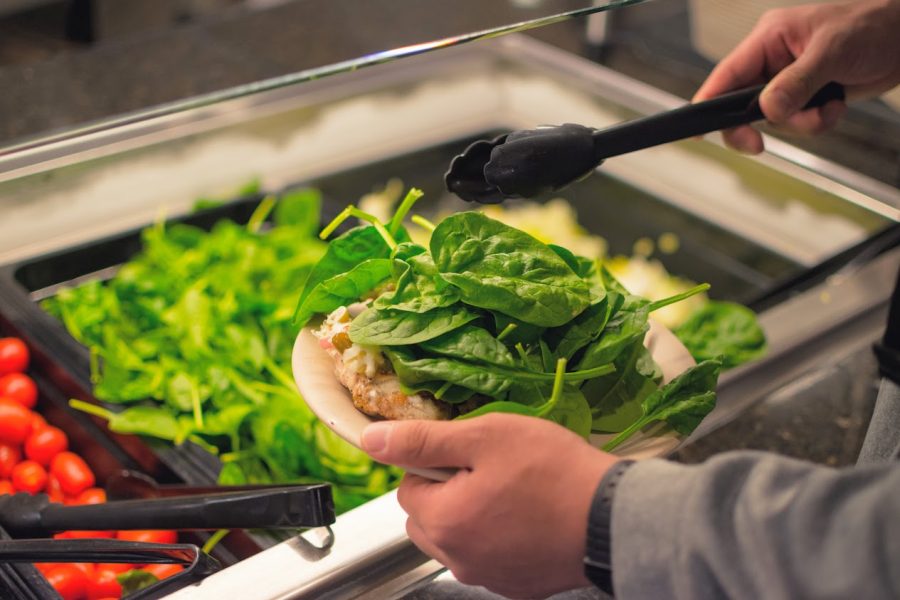“Lettuce” eat: University conducts analysis into vegetable consumption
A student puts greens on their plate at a salad bar located in the SDRP on April 27, 2018. Researchers at the University have recently investigated claims surrounding vegetables.
Sep 8, 2020
Last updated on Oct. 29, 2024 at 04:07 p.m.
According to a 2017 study by the Center for Disease Control, the recommended amount of daily vegetable intake is two to three cups of vegetables per day. Research revealed, however, that only one in ten adults meet recommendations for daily vegetable and fruit intake. Luckily, altering how food is prepared can create a positive impact on the purchasing and consumption of vegetables. This can lead to a higher quantity of vegetables eaten, providing many health benefits to students.
Researchers at the University have been conducting research to find ways to promote more vegetable intake. One study assessed how seasoning affected the purchasing of vegetables. Nickols-Richardson, professor in ACES, was a collaborator in a study that investigated how seasoning vegetables could impact purchasing decisions and consequently vegetable intake. The study assessed whether individuals more frequently purchased steamed vegetables or seasoned vegetables, along with the degree of liking of the purchased vegetables.
To conduct the study, Nicklos-Richardson and colleagues used green beans, broccoli, carrots and cauliflower to assess how people purchased these vegetables based on how they were prepared. The experiment was completed in a university-based cafeteria. All the vegetables were steamed in soybean oil, though additional seasonings were added to make the seasoned vegetables. Some of these seasonings included garlic powder, onion powder, ground black pepper and dried dill weed.
The cafeteria offered either steamed or seasoned vegetables at the same price point. Participants could choose whichever vegetables they wanted. Researchers used a system of colored plates to determine whether people had taken the steamed or seasoned vegetables. In addition, a survey was used to gain more information about the reasoning for vegetable choice and the liking of the vegetables they bought.
Get The Daily Illini in your inbox!
Results indicated that participants chose seasoned green beans, broccoli and cauliflower more than they chose the steamed options; no such comparison existed for seasoned carrots. Participants liked both the seasoned and steamed vegetables, giving them an average liking score of 7.32.
Gender also played a unique role in how vegetables were bought, as males bought the seasoned vegetables more than the females. However, men did buy fewer vegetables than women. This finding emphasizes the need for further research into how consumer behavior can impact vegetable consumption.
The results of this study prompt food preparation workers to be aware of the interest that consumers show in vegetables based on the way they are prepared. Different vegetables may need to be prepared in different ways to yield consumption. A collaboration between researchers and food preparation workers can facilitate communities to promote vegetable intake in enticing ways, leading to a higher adherence to vegetables.
Adequate vegetable intake is important because research shows sufficient consumption leads to healthier outcomes. For example, a study found a relationship between increased vegetable intake and a decreased risk of cardiovascular disease. With this disease being the most common cause of death in the United States, it is important to understand how people’s food intake can enhance their health. Smart choices lead to healthier lives with reduced risk of chronic diseases.
Additionally, a study of individuals in the United Kingdom examined how sleep duration impacted fruit and vegetable choice. The results found that those who slept the recommended amount, eight hours or more per night, choose to consume more fruits and vegetables than those who slept the shorter duration, seven hours or less per night.
Sleep seems to facilitate healthier behaviors. While it is evident that college students consistently do not get enough sleep, sleep may be an important factor in deciding to eat one extra vegetable that day.
Regardless of whether individuals are buying vegetables from a cafeteria or making a vegetable platter at home, seasoning can increase their palatability, making vegetables more enjoyable to eat.






